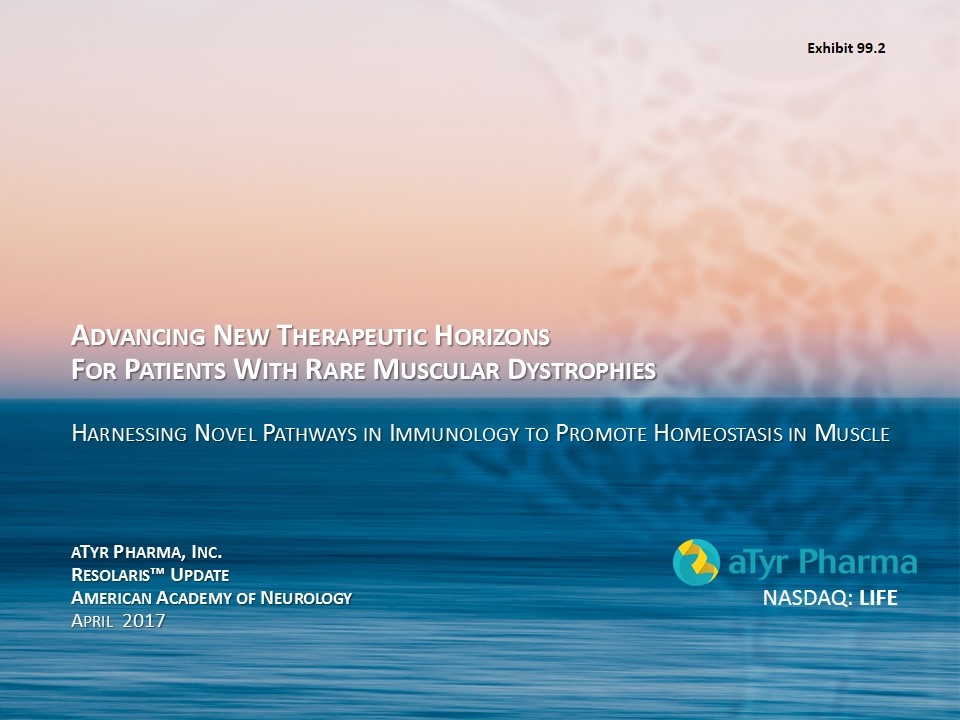
NASDAQ: LIFE Advancing New Therapeutic Horizons For Patients With Rare Muscular Dystrophies Harnessing Novel Pathways in Immunology to Promote Homeostasis in Muscle aTyr Pharma, Inc. Resolaris™ Update American Academy of Neurology April 2017 Exhibit 99.2
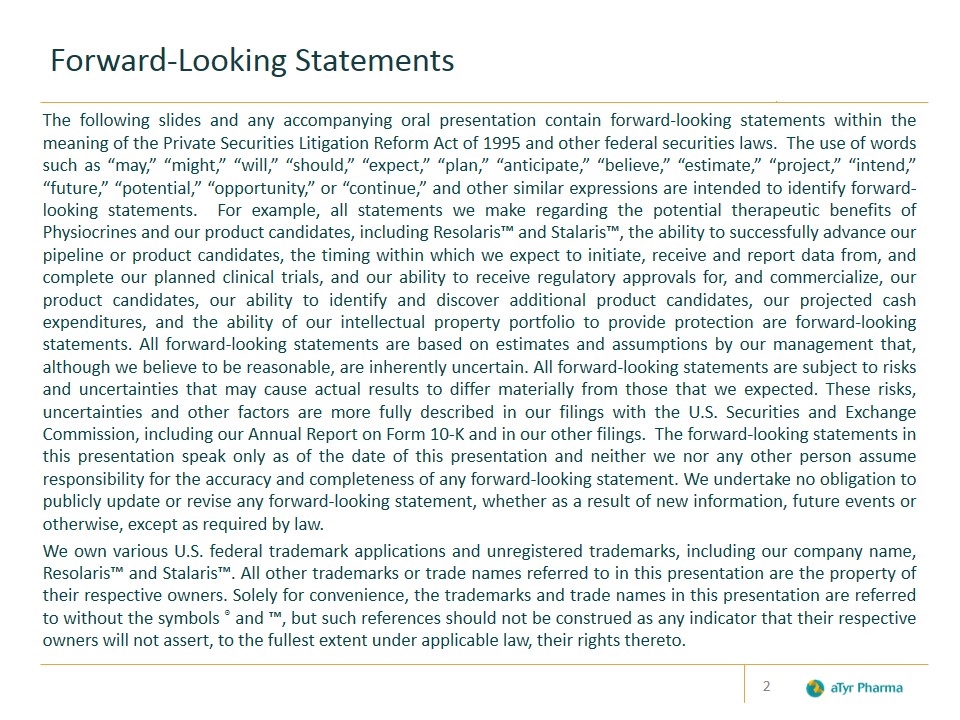
Forward-Looking Statements The following slides and any accompanying oral presentation contain forward-looking statements within the meaning of the Private Securities Litigation Reform Act of 1995 and other federal securities laws. The use of words such as “may,” “might,” “will,” “should,” “expect,” “plan,” “anticipate,” “believe,” “estimate,” “project,” “intend,” “future,” “potential,” “opportunity,” or “continue,” and other similar expressions are intended to identify forward-looking statements. For example, all statements we make regarding the potential therapeutic benefits of Physiocrines and our product candidates, including Resolaris™ and Stalaris™, the ability to successfully advance our pipeline or product candidates, the timing within which we expect to initiate, receive and report data from, and complete our planned clinical trials, and our ability to receive regulatory approvals for, and commercialize, our product candidates, our ability to identify and discover additional product candidates, our projected cash expenditures, and the ability of our intellectual property portfolio to provide protection are forward-looking statements. All forward-looking statements are based on estimates and assumptions by our management that, although we believe to be reasonable, are inherently uncertain. All forward-looking statements are subject to risks and uncertainties that may cause actual results to differ materially from those that we expected. These risks, uncertainties and other factors are more fully described in our filings with the U.S. Securities and Exchange Commission, including our Annual Report on Form 10-K and in our other filings. The forward-looking statements in this presentation speak only as of the date of this presentation and neither we nor any other person assume responsibility for the accuracy and completeness of any forward-looking statement. We undertake no obligation to publicly update or revise any forward-looking statement, whether as a result of new information, future events or otherwise, except as required by law. We own various U.S. federal trademark applications and unregistered trademarks, including our company name, Resolaris™ and Stalaris™. All other trademarks or trade names referred to in this presentation are the property of their respective owners. Solely for convenience, the trademarks and trade names in this presentation are referred to without the symbols ® and ™, but such references should not be construed as any indicator that their respective owners will not assert, to the fullest extent under applicable law, their rights thereto.
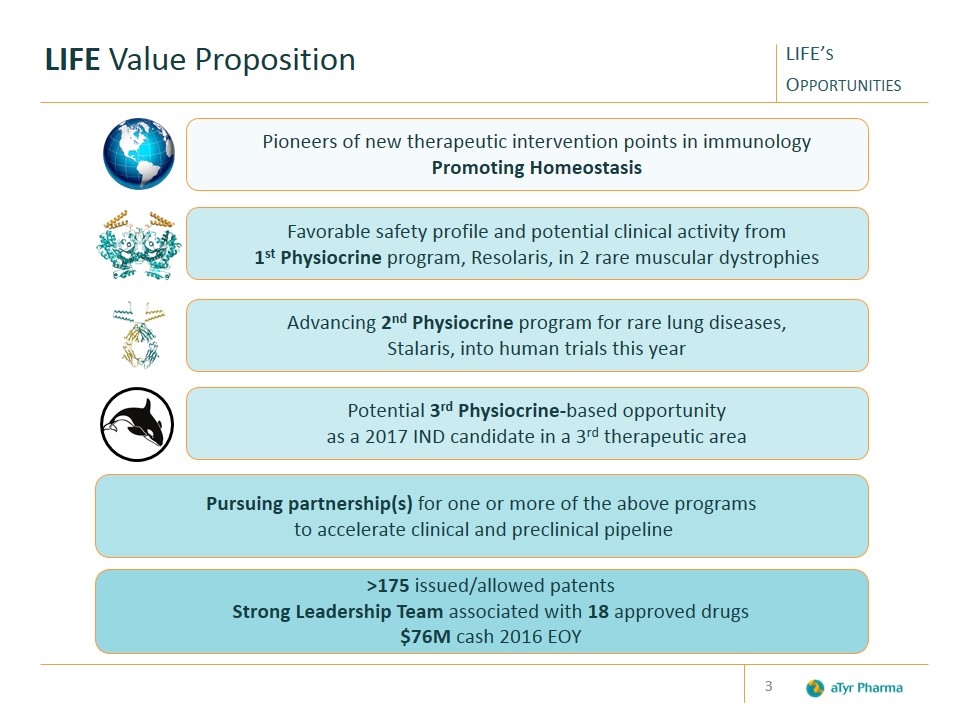
>175 issued/allowed patents Strong Leadership Team associated with 18 approved drugs $76M cash 2016 EOY Pursuing partnership(s) for one or more of the above programs to accelerate clinical and preclinical pipeline Pioneers of new therapeutic intervention points in immunology Promoting Homeostasis LIFE Value Proposition LIFE’s Opportunities Potential 3rd Physiocrine-based opportunity as a 2017 IND candidate in a 3rd therapeutic area Favorable safety profile and potential clinical activity from 1st Physiocrine program, Resolaris, in 2 rare muscular dystrophies Advancing 2nd Physiocrine program for rare lung diseases, Stalaris, into human trials this year
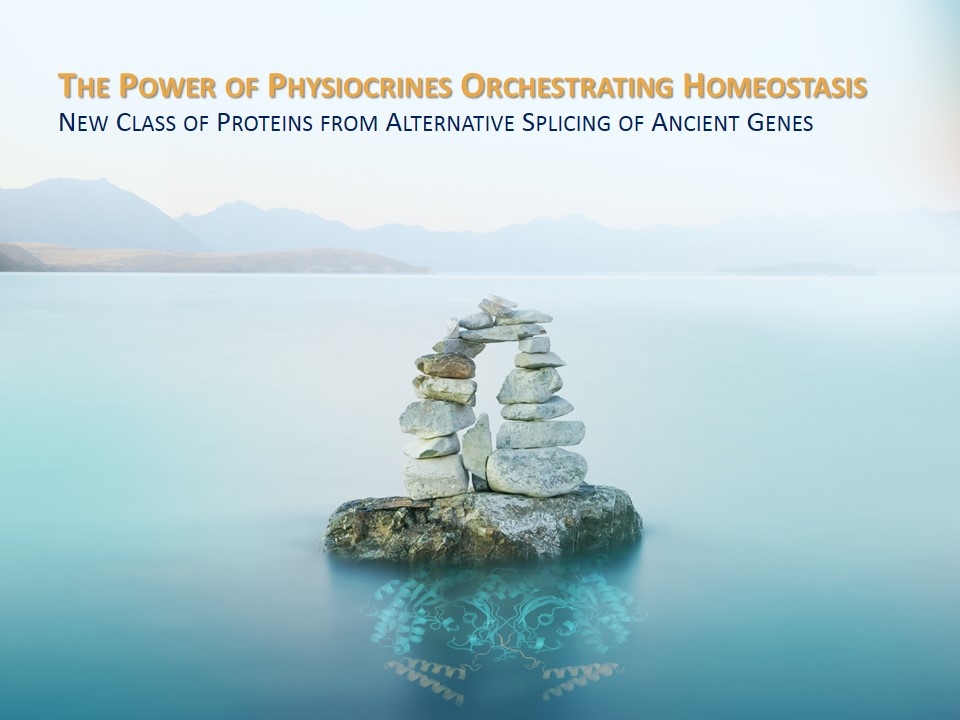
The Power of Physiocrines Orchestrating Homeostasis New Class of Proteins from Alternative Splicing of Ancient Genes
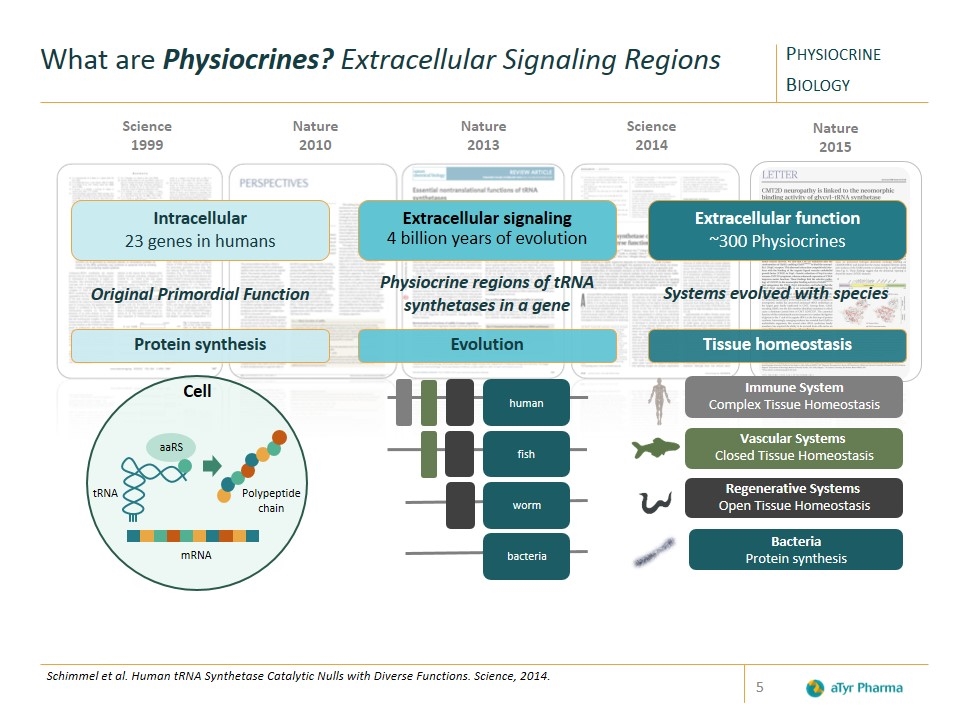
Nature 2015 Science 2014 Nature 2013 Nature 2010 Science 1999 What are Physiocrines? Extracellular Signaling Regions Physiocrine Biology Protein synthesis Original Primordial Function Intracellular 23 genes in humans Physiocrine regions of tRNA synthetases in a gene Extracellular signaling 4 billion years of evolution bacteria fish worm human Vascular Systems Closed Tissue Homeostasis Regenerative Systems Open Tissue Homeostasis Systems evolved with species Extracellular function ~300 Physiocrines Immune System Complex Tissue Homeostasis Tissue homeostasis Evolution Cell aaRS Polypeptide chain mRNA tRNA Schimmel et al. Human tRNA Synthetase Catalytic Nulls with Diverse Functions. Science, 2014. Bacteria Protein synthesis
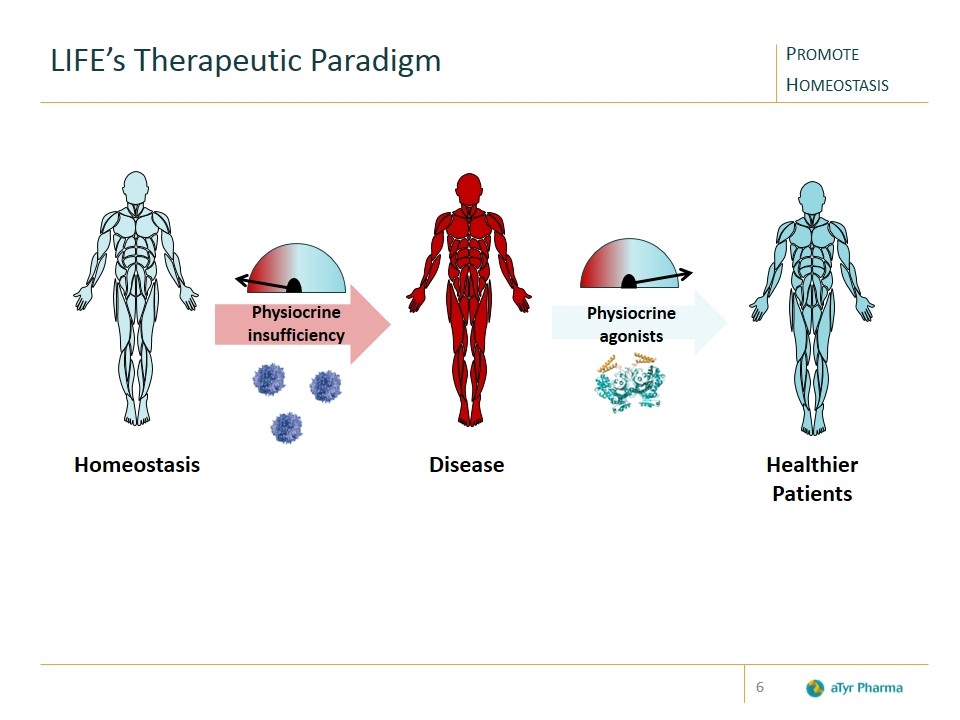
Promote Homeostasis LIFE’s Therapeutic Paradigm Homeostasis Disease Healthier Patients Physiocrine insufficiency Physiocrine agonists
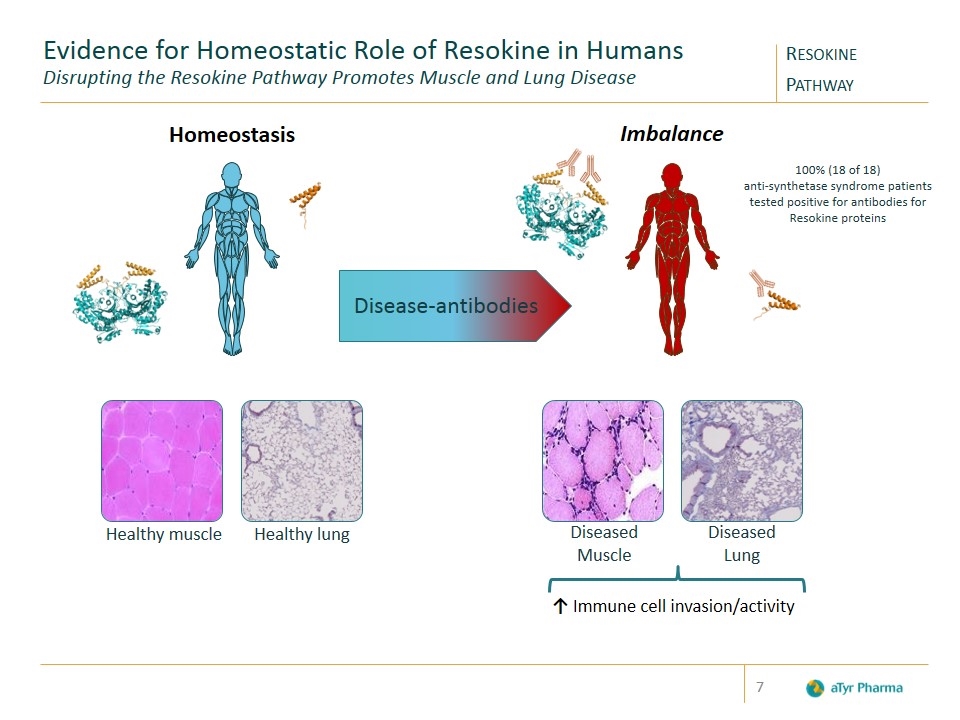
Evidence for Homeostatic Role of Resokine in Humans Disrupting the Resokine Pathway Promotes Muscle and Lung Disease Disease-antibodies Homeostasis Imbalance ↑ Immune cell invasion/activity Resokine Pathway Diseased Muscle Diseased Lung Healthy muscle Healthy lung 100% (18 of 18) anti-synthetase syndrome patients tested positive for antibodies for Resokine proteins
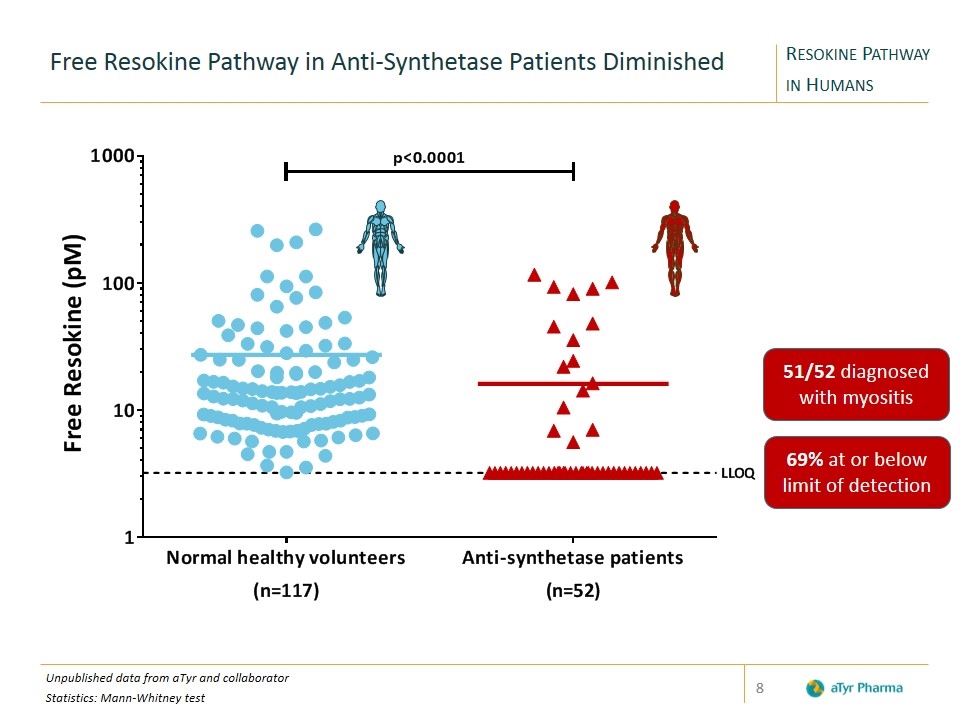
Free Resokine Pathway in Anti-Synthetase Patients Diminished Unpublished data from aTyr and collaborator Statistics: Mann-Whitney test Resokine Pathway in Humans 69% at or below limit of detection 51/52 diagnosed with myositis

Agonists of the Resokine Pathway in Immune Driven Models Balancing the immune response to tissue insults In vivo administration of Resokine proteins to animal models of T cell driven disease states. Cell type indicates type of cells involved but may not be limited to these cells. Resokine Pathway Immune Targets Disease Model Resokine Homeostatic Effect Skeletal Muscle Statin Induced Myopathy CD4/CD8 & macrophages Lung Bleomycin Induced Lung Fibrosis Th17/CD4 Colon TNBS Induced Colitis Th17/CD4 Skin IL23 Induced Psoriasis Th17/CD4
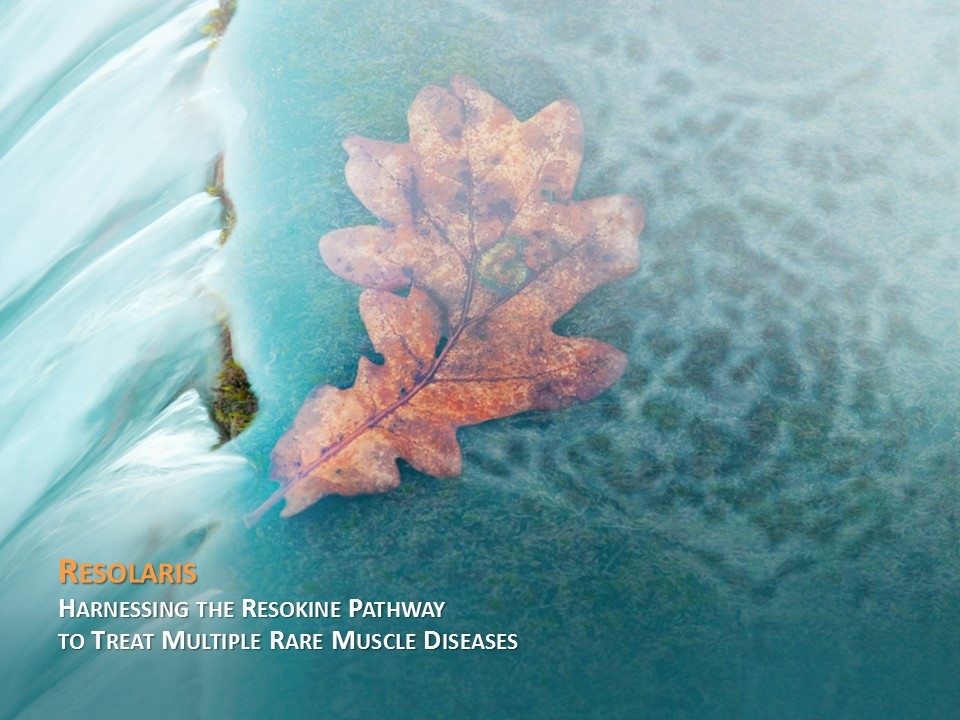
Resolaris Harnessing the Resokine Pathway to Treat Multiple Rare Muscle Diseases
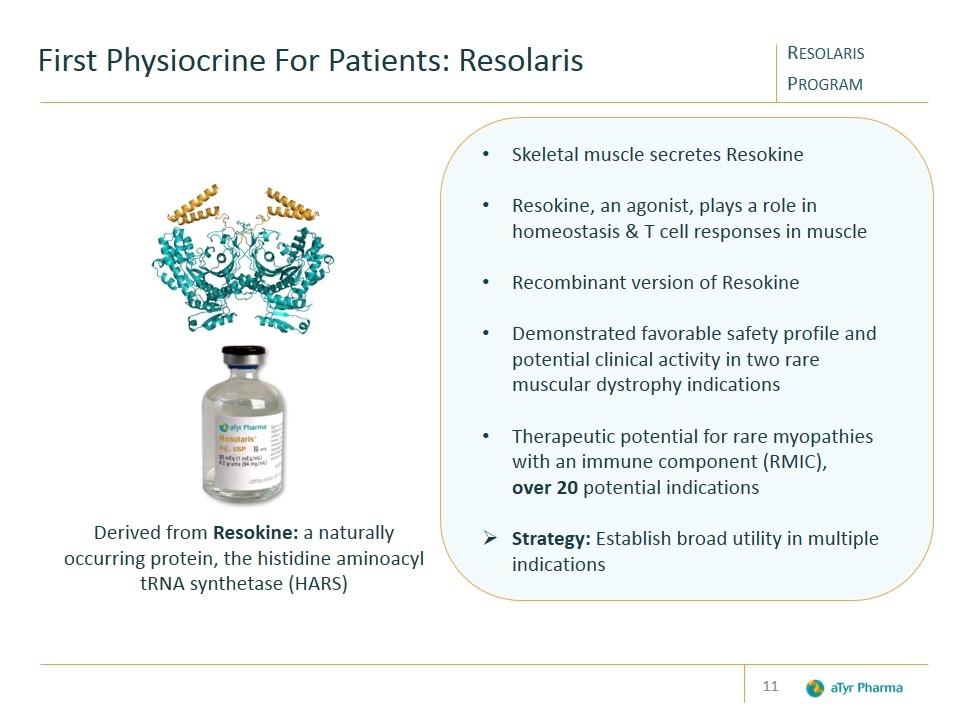
First Physiocrine For Patients: Resolaris Skeletal muscle secretes Resokine Resokine, an agonist, plays a role in homeostasis & T cell responses in muscle Recombinant version of Resokine Demonstrated favorable safety profile and potential clinical activity in two rare muscular dystrophy indications Therapeutic potential for rare myopathies with an immune component (RMIC), over 20 potential indications Strategy: Establish broad utility in multiple indications Resolaris Program Derived from Resokine: a naturally occurring protein, the histidine aminoacyl tRNA synthetase (HARS)
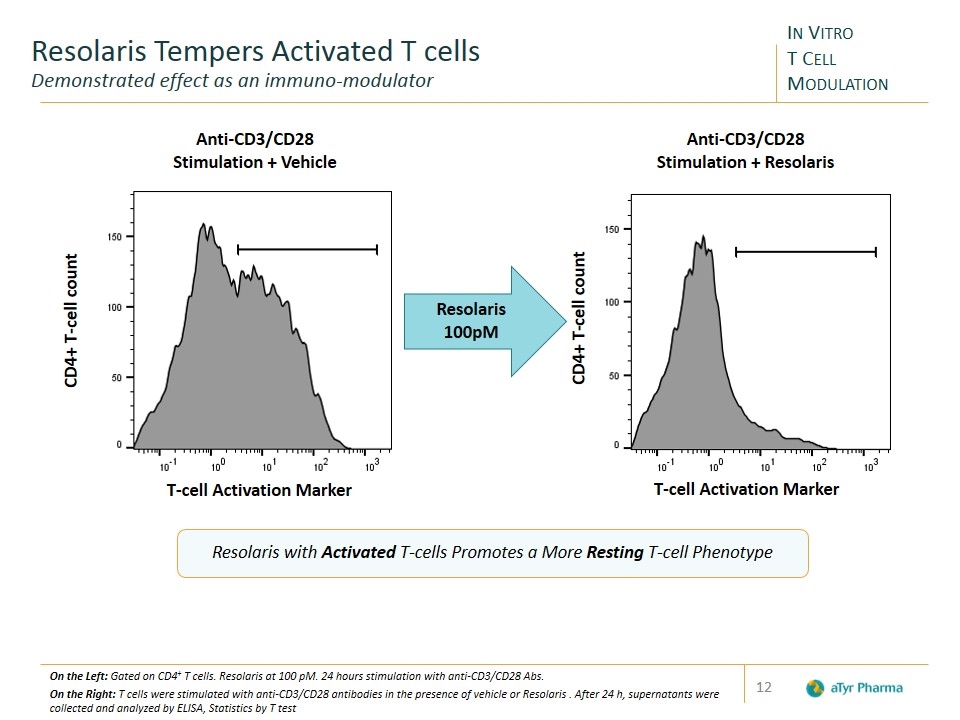
Resolaris Tempers Activated T cells Demonstrated effect as an immuno-modulator In Vitro T Cell Modulation Resolaris with Activated T-cells Promotes a More Resting T-cell Phenotype On the Left: Gated on CD4+ T cells. Resolaris at 100 pM. 24 hours stimulation with anti-CD3/CD28 Abs. On the Right: T cells were stimulated with anti-CD3/CD28 antibodies in the presence of vehicle or Resolaris . After 24 h, supernatants were collected and analyzed by ELISA, Statistics by T test Anti-CD3/CD28 Stimulation + Vehicle T-cell Activation Marker CD4+ T-cell count Anti-CD3/CD28 Stimulation + Resolaris T-cell Activation Marker CD4+ T-cell count Resolaris 100pM
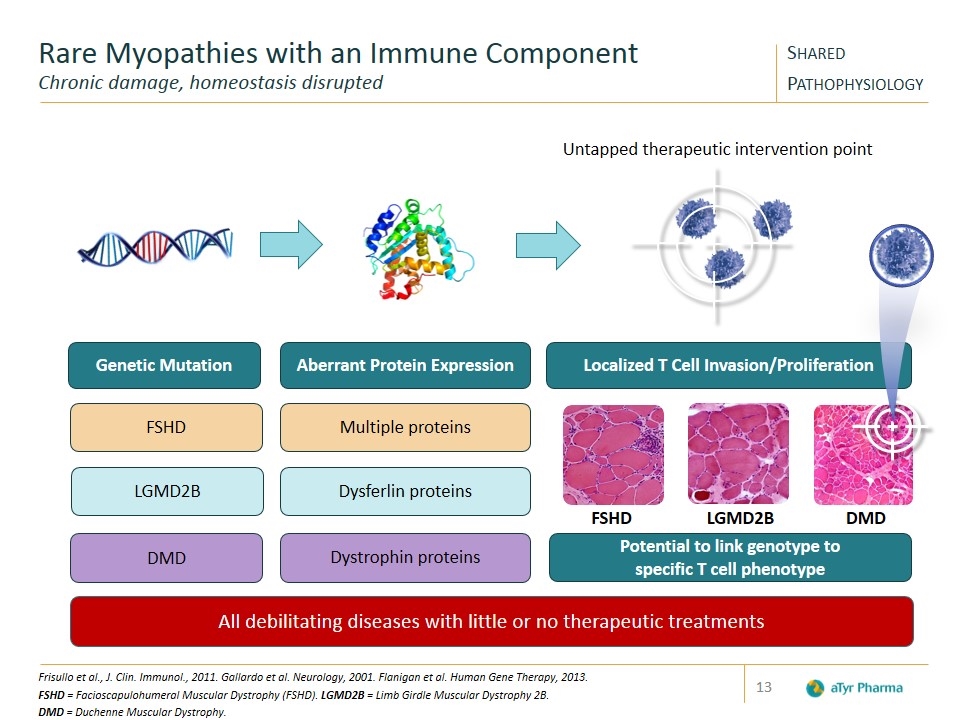
Rare Myopathies with an Immune Component Chronic damage, homeostasis disrupted Genetic Mutation Multiple proteins Dysferlin proteins Dystrophin proteins FSHD LGMD2B DMD Aberrant Protein Expression Localized T Cell Invasion/Proliferation Potential to link genotype to specific T cell phenotype FSHD LGMD2B DMD Untapped therapeutic intervention point Frisullo et al., J. Clin. Immunol., 2011. Gallardo et al. Neurology, 2001. Flanigan et al. Human Gene Therapy, 2013. FSHD = Facioscapulohumeral Muscular Dystrophy (FSHD). LGMD2B = Limb Girdle Muscular Dystrophy 2B. DMD = Duchenne Muscular Dystrophy. Shared Pathophysiology All debilitating diseases with little or no therapeutic treatments
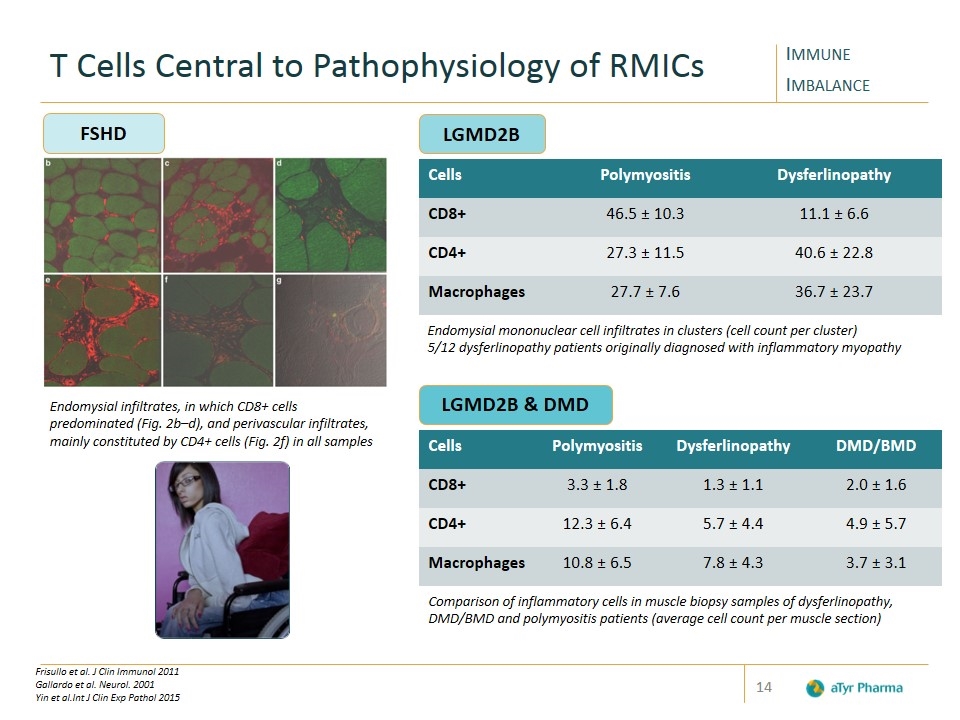
T Cells Central to Pathophysiology of RMICs Frisullo et al. J Clin Immunol 2011 Gallardo et al. Neurol. 2001 Yin et al.Int J Clin Exp Pathol 2015 Endomysial infiltrates, in which CD8+ cells predominated (Fig. 2b–d), and perivascular infiltrates, mainly constituted by CD4+ cells (Fig. 2f) in all samples LGMD2B FSHD LGMD2B & DMD Cells Polymyositis Dysferlinopathy CD8+ 46.5 ± 10.3 11.1 ± 6.6 CD4+ 27.3 ± 11.5 40.6 ± 22.8 Macrophages 27.7 ± 7.6 36.7 ± 23.7 Cells Polymyositis Dysferlinopathy DMD/BMD CD8+ 3.3 ± 1.8 1.3 ± 1.1 2.0 ± 1.6 CD4+ 12.3 ± 6.4 5.7 ± 4.4 4.9 ± 5.7 Macrophages 10.8 ± 6.5 7.8 ± 4.3 3.7 ± 3.1 Endomysial mononuclear cell infiltrates in clusters (cell count per cluster) 5/12 dysferlinopathy patients originally diagnosed with inflammatory myopathy Comparison of inflammatory cells in muscle biopsy samples of dysferlinopathy, DMD/BMD and polymyositis patients (average cell count per muscle section) Immune Imbalance
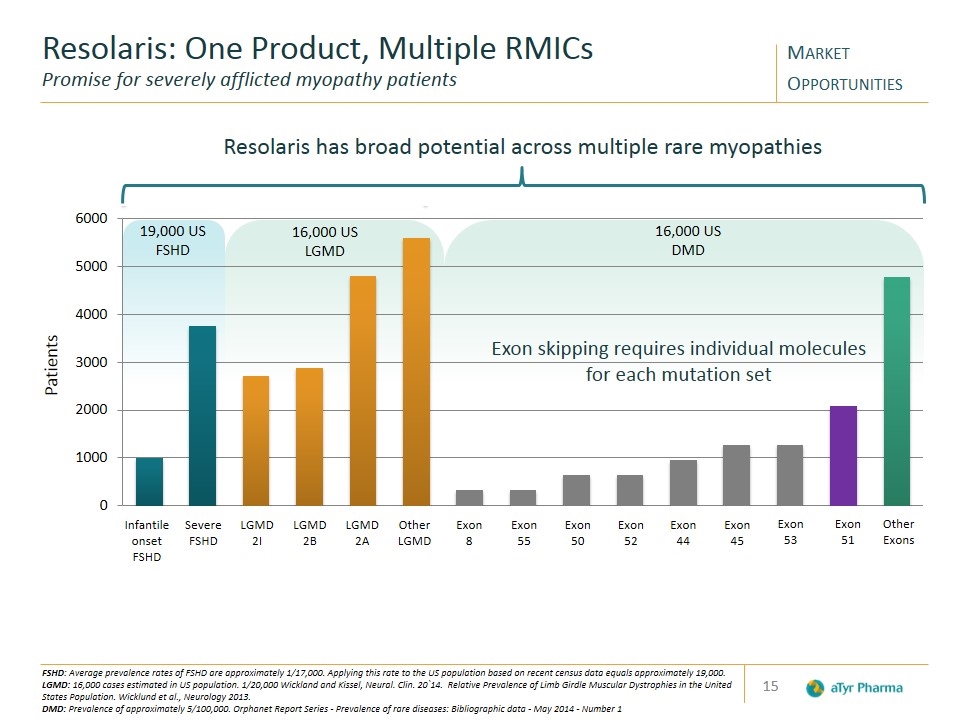
Resolaris: One Product, Multiple RMICs Promise for severely afflicted myopathy patients FSHD: Average prevalence rates of FSHD are approximately 1/17,000. Applying this rate to the US population based on recent census data equals approximately 19,000. LGMD: 16,000 cases estimated in US population. 1/20,000 Wickland and Kissel, Neural. Clin. 20`14. Relative Prevalence of Limb Girdle Muscular Dystrophies in the United States Population. Wicklund et al., Neurology 2013. DMD: Prevalence of approximately 5/100,000. Orphanet Report Series - Prevalence of rare diseases: Bibliographic data - May 2014 - Number 1 Infantile onset FSHD Severe FSHD LGMD 2I LGMD 2B LGMD 2A Other LGMD Exon 8 Exon 55 Exon 50 Exon 52 Exon 44 Exon 45 Exon 53 Exon 51 Other Exons 19,000 US FSHD 16,000 US LGMD 16,000 US DMD Resolaris Exon skipping requires individual molecules for each mutation set Market Opportunities Resolaris has broad potential across multiple rare myopathies Patients
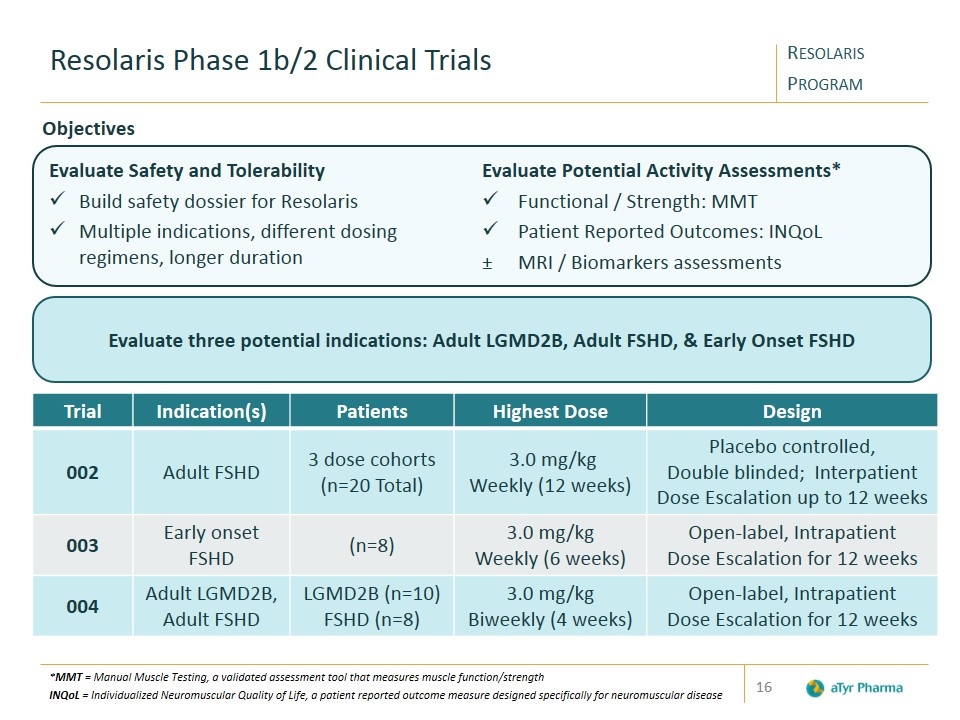
Resolaris Phase 1b/2 Clinical Trials Trial Indication(s) Patients Highest Dose Design 002 Adult FSHD 3 dose cohorts (n=20 Total) 3.0 mg/kg Weekly (12 weeks) Placebo controlled, Double blinded; Interpatient Dose Escalation up to 12 weeks 003 Early onset FSHD (n=8) 3.0 mg/kg Weekly (6 weeks) Open-label, Intrapatient Dose Escalation for 12 weeks 004 Adult LGMD2B, Adult FSHD LGMD2B (n=10) FSHD (n=8) 3.0 mg/kg Biweekly (4 weeks) Open-label, Intrapatient Dose Escalation for 12 weeks Evaluate Safety and Tolerability Build safety dossier for Resolaris Multiple indications, different dosing regimens, longer duration Evaluate Potential Activity Assessments* Functional / Strength: MMT Patient Reported Outcomes: INQoL MRI / Biomarkers assessments Resolaris Program Objectives *MMT = Manual Muscle Testing, a validated assessment tool that measures muscle function/strength INQoL = Individualized Neuromuscular Quality of Life, a patient reported outcome measure designed specifically for neuromuscular disease Evaluate three potential indications: Adult LGMD2B, Adult FSHD, & Early Onset FSHD
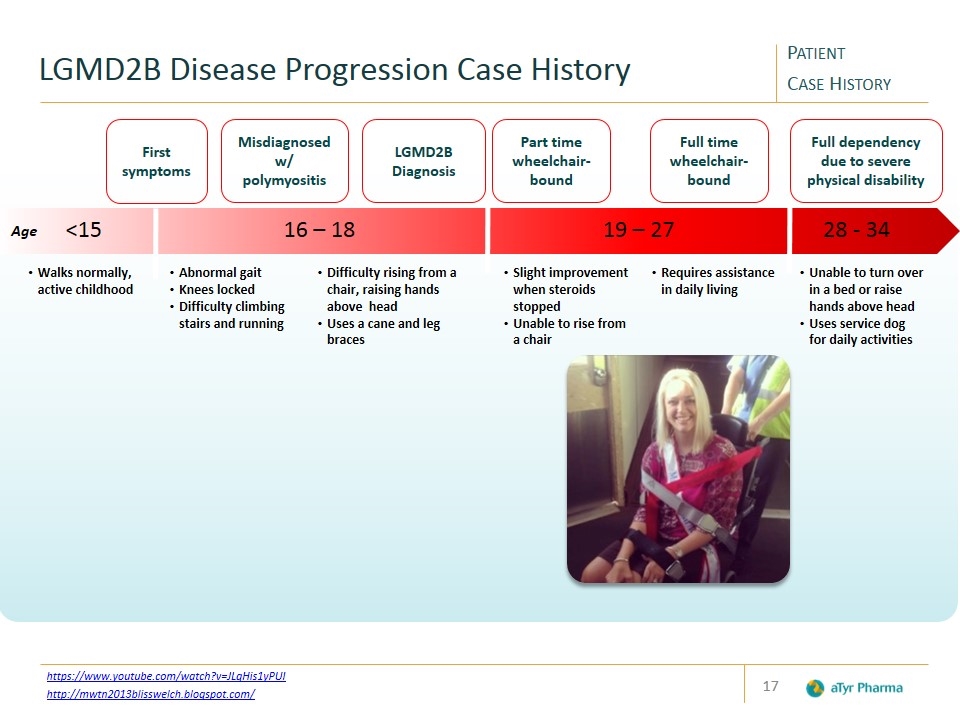
LGMD2B Disease Progression Case History Difficulty rising from a chair, raising hands above head Uses a cane and leg braces Walks normally, active childhood Abnormal gait Knees locked Difficulty climbing stairs and running Age <15 16 – 18 19 – 27 28 - 34 https://www.youtube.com/watch?v=JLqHis1yPUI http://mwtn2013blisswelch.blogspot.com/ Unable to turn over in a bed or raise hands above head Uses service dog for daily activities Slight improvement when steroids stopped Unable to rise from a chair Requires assistance in daily living LGMD2B Diagnosis Misdiagnosed w/ polymyositis Part time wheelchair-bound First symptoms Full dependency due to severe physical disability Full time wheelchair-bound Patient Case History
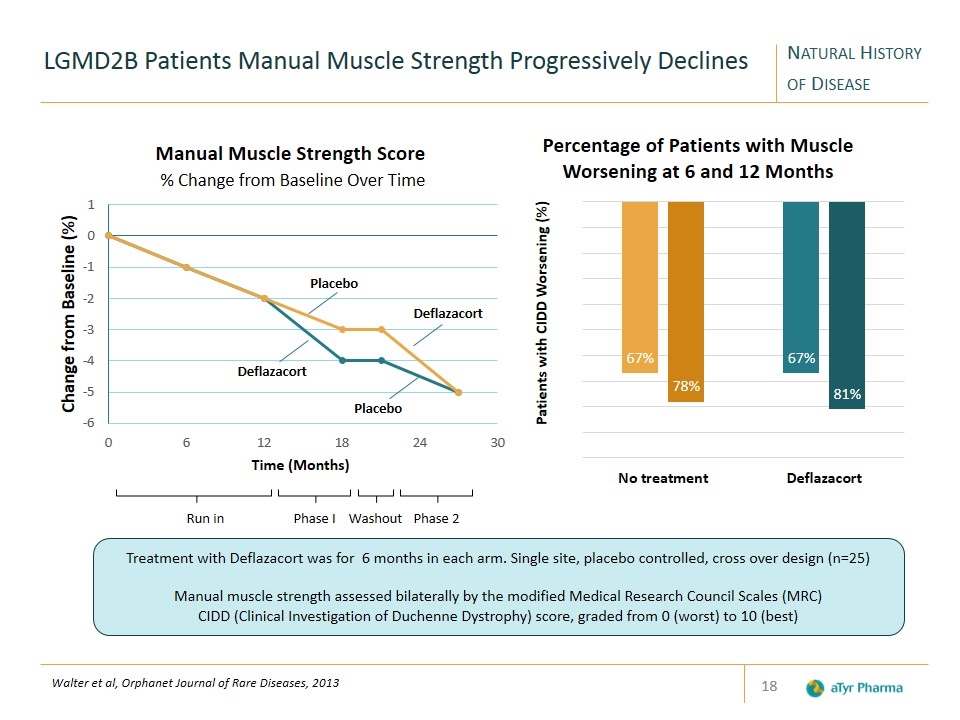
LGMD2B Patients Manual Muscle Strength Progressively Declines Treatment with Deflazacort was for 6 months in each arm. Single site, placebo controlled, cross over design (n=25) Manual muscle strength assessed bilaterally by the modified Medical Research Council Scales (MRC) CIDD (Clinical Investigation of Duchenne Dystrophy) score, graded from 0 (worst) to 10 (best) Run in Phase I Washout Phase 2 Deflazacort Deflazacort Walter et al, Orphanet Journal of Rare Diseases, 2013 Placebo Placebo Natural History of Disease
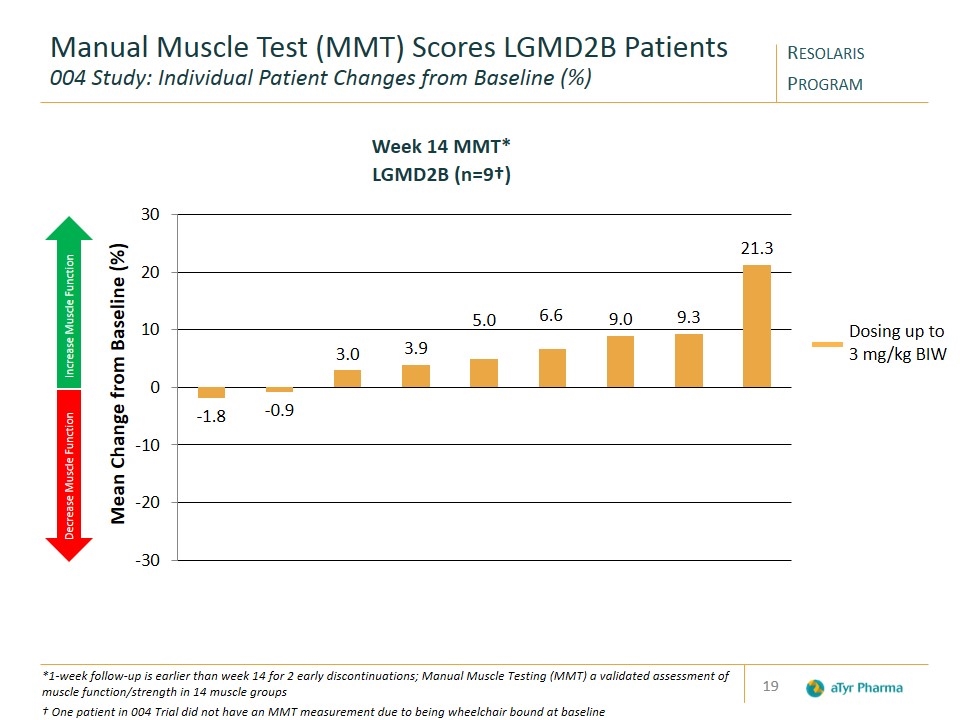
Manual Muscle Test (MMT) Scores LGMD2B Patients 004 Study: Individual Patient Changes from Baseline (%) *1-week follow-up is earlier than week 14 for 2 early discontinuations; Manual Muscle Testing (MMT) a validated assessment of muscle function/strength in 14 muscle groups † One patient in 004 Trial did not have an MMT measurement due to being wheelchair bound at baseline Dosing up to 3 mg/kg BIW Week 14 MMT* LGMD2B (n=9†) Decrease Muscle Function Increase Muscle Function Resolaris Program
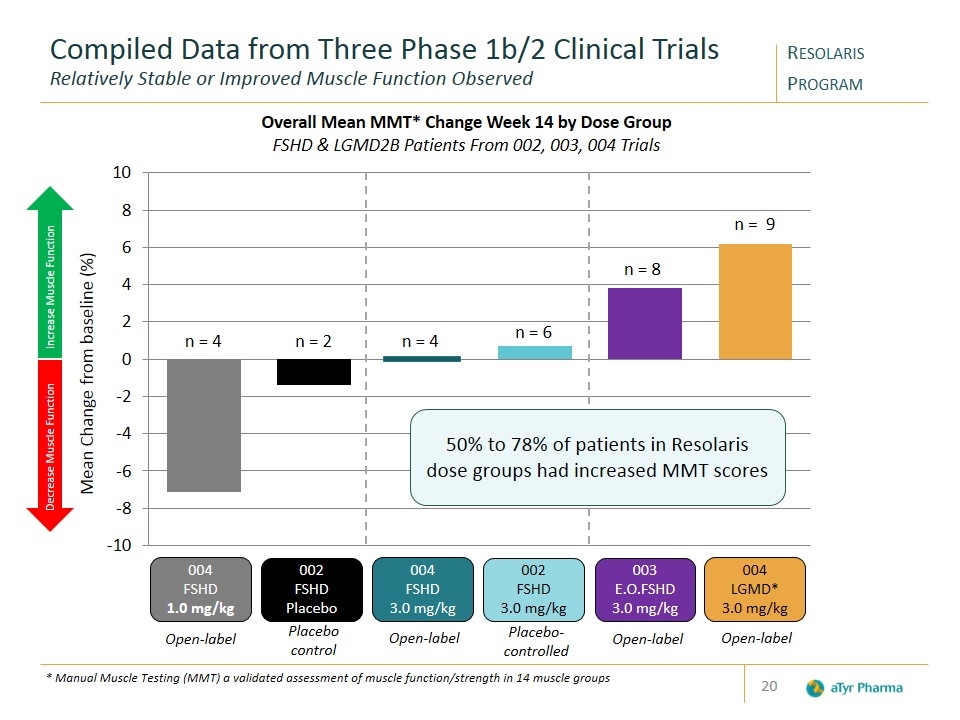
Compiled Data from Three Phase 1b/2 Clinical Trials Relatively Stable or Improved Muscle Function Observed n = 4 n = 2 n = 4 n = 8 n = 9 Overall Mean MMT* Change Week 14 by Dose Group FSHD & LGMD2B Patients From 002, 003, 004 Trials Mean Change from baseline (%) Decrease Muscle Function Increase Muscle Function n = 6 002 FSHD 3.0 mg/kg Placebo-controlled 004 FSHD 1.0 mg/kg Open-label 004 LGMD* 3.0 mg/kg Open-label 003 E.O.FSHD 3.0 mg/kg Open-label 004 FSHD 3.0 mg/kg Open-label Resolaris Program * Manual Muscle Testing (MMT) a validated assessment of muscle function/strength in 14 muscle groups 002 FSHD Placebo Placebo control 50% to 78% of patients in Resolaris dose groups had increased MMT scores
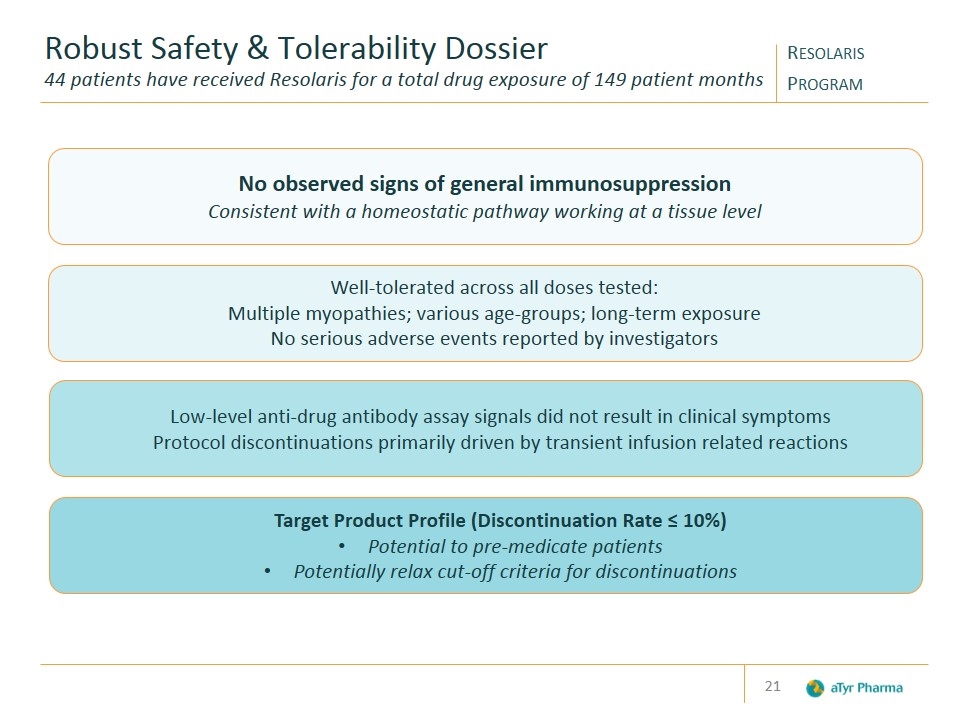
Low-level anti-drug antibody assay signals did not result in clinical symptoms Protocol discontinuations primarily driven by transient infusion related reactions Robust Safety & Tolerability Dossier 44 patients have received Resolaris for a total drug exposure of 149 patient months No observed signs of general immunosuppression Consistent with a homeostatic pathway working at a tissue level Well-tolerated across all doses tested: Multiple myopathies; various age-groups; long-term exposure No serious adverse events reported by investigators Target Product Profile (Discontinuation Rate ≤ 10%) Potential to pre-medicate patients Potentially relax cut-off criteria for discontinuations Resolaris Program
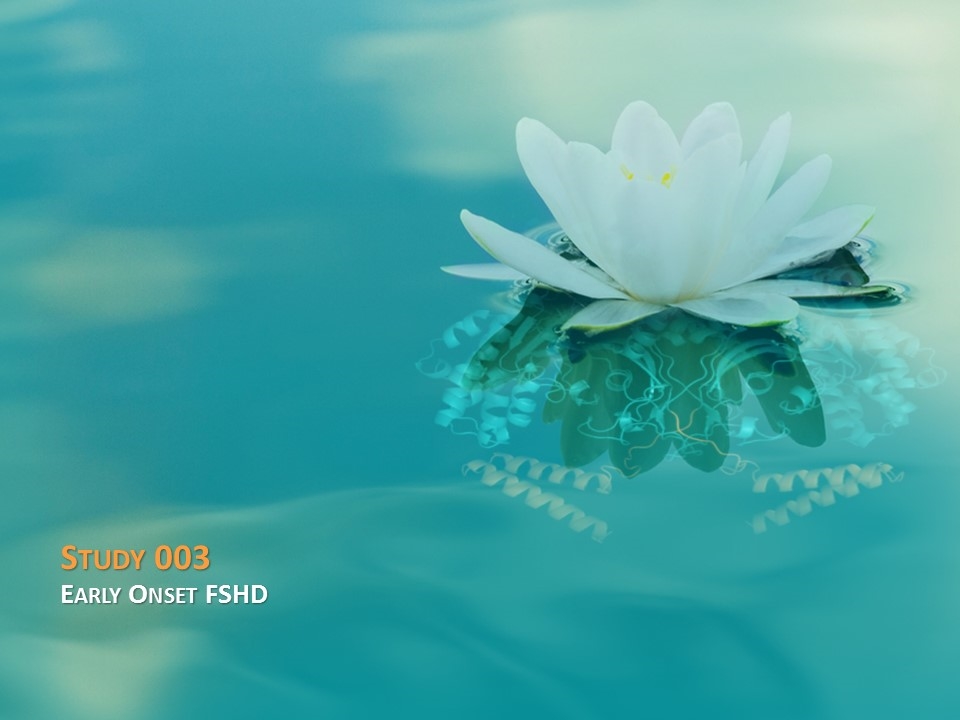
Study 003 Early Onset FSHD
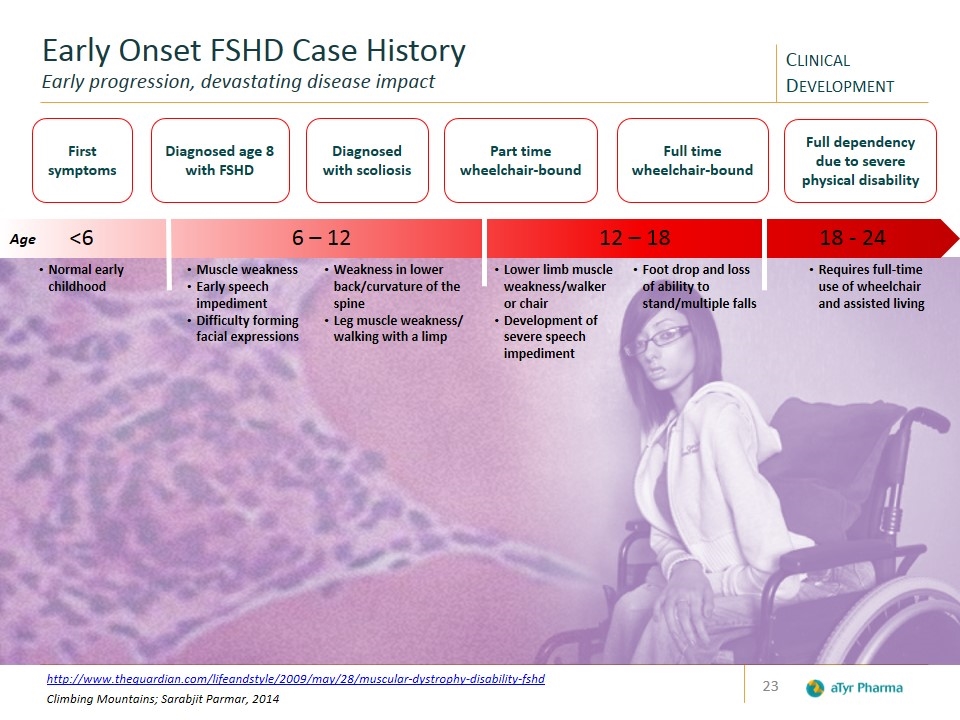
Early Onset FSHD Case History Early progression, devastating disease impact Weakness in lower back/curvature of the spine Leg muscle weakness/ walking with a limp Normal early childhood Requires full-time use of wheelchair and assisted living Diagnosed with scoliosis Muscle weakness Early speech impediment Difficulty forming facial expressions Lower limb muscle weakness/walker or chair Development of severe speech impediment Foot drop and loss of ability to stand/multiple falls Diagnosed age 8 with FSHD Part time wheelchair-bound Age First symptoms Full dependency due to severe physical disability <6 6 – 12 12 – 18 18 - 24 http://www.theguardian.com/lifeandstyle/2009/may/28/muscular-dystrophy-disability-fshd Climbing Mountains; Sarabjit Parmar, 2014 Full time wheelchair-bound Clinical Development
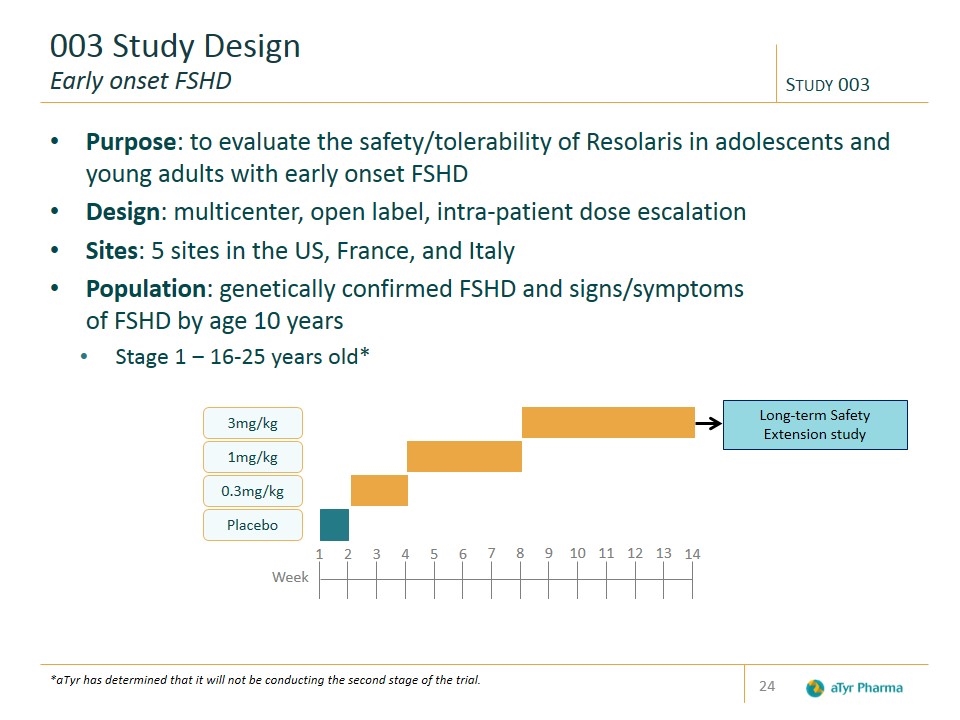
Purpose: to evaluate the safety/tolerability of Resolaris in adolescents and young adults with early onset FSHD Design: multicenter, open label, intra-patient dose escalation Sites: 5 sites in the US, France, and Italy Population: genetically confirmed FSHD and signs/symptoms of FSHD by age 10 years Stage 1 ‒ 16-25 years old* *aTyr has determined that it will not be conducting the second stage of the trial. 003 Study Design Early onset FSHD 3mg/kg 1mg/kg 0.3mg/kg Placebo Long-term Safety Extension study Week 3 4 1 2 7 8 5 6 9 12 13 10 11 14 Study 003
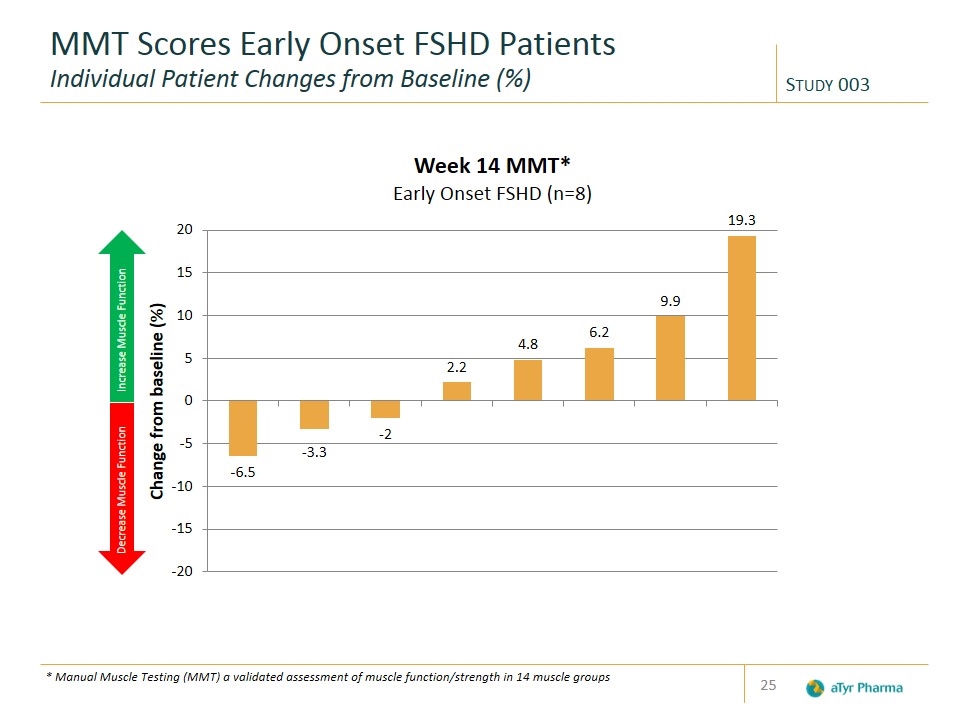
MMT Scores Early Onset FSHD Patients Individual Patient Changes from Baseline (%) Study 003 * Manual Muscle Testing (MMT) a validated assessment of muscle function/strength in 14 muscle groups
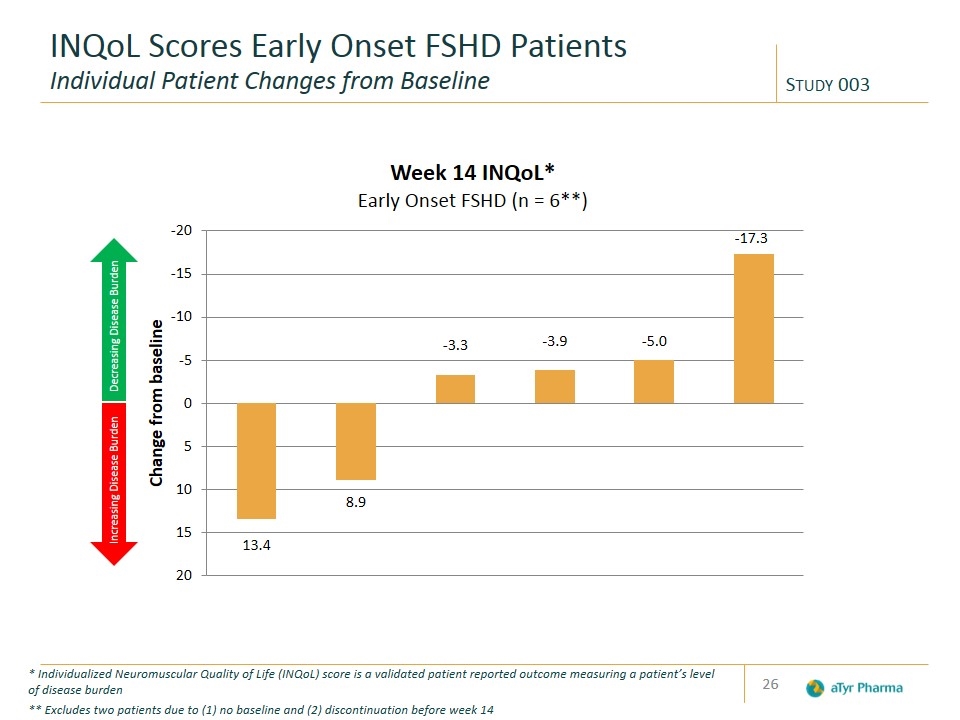
* Individualized Neuromuscular Quality of Life (INQoL) score is a validated patient reported outcome measuring a patient’s level of disease burden ** Excludes two patients due to (1) no baseline and (2) discontinuation before week 14 INQoL Scores Early Onset FSHD Patients Individual Patient Changes from Baseline Increasing Disease Burden Decreasing Disease Burden Study 003
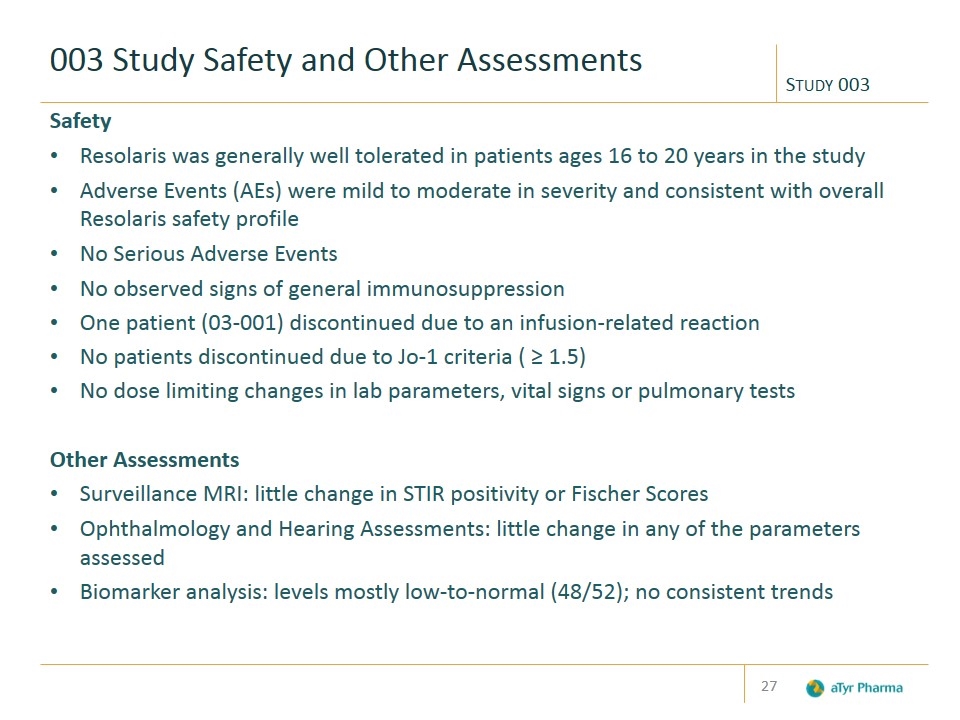
003 Study Safety and Other Assessments Safety Resolaris was generally well tolerated in patients ages 16 to 20 years in the study Adverse Events (AEs) were mild to moderate in severity and consistent with overall Resolaris safety profile No Serious Adverse Events No observed signs of general immunosuppression One patient (03-001) discontinued due to an infusion-related reaction No patients discontinued due to Jo-1 criteria ( ≥ 1.5) No dose limiting changes in lab parameters, vital signs or pulmonary tests Other Assessments Surveillance MRI: little change in STIR positivity or Fischer Scores Ophthalmology and Hearing Assessments: little change in any of the parameters assessed Biomarker analysis: levels mostly low-to-normal (48/52); no consistent trends Study 003
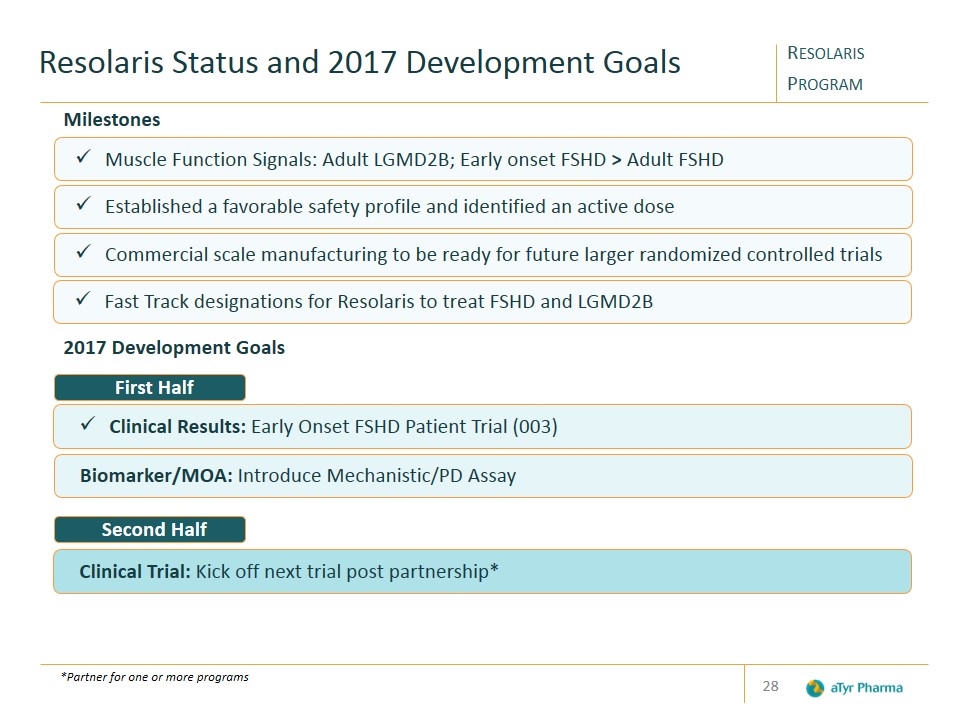
Second Half First Half Resolaris Status and 2017 Development Goals Clinical Results: Early Onset FSHD Patient Trial (003) Clinical Trial: Kick off next trial post partnership* Biomarker/MOA: Introduce Mechanistic/PD Assay Established a favorable safety profile and identified an active dose Muscle Function Signals: Adult LGMD2B; Early onset FSHD > Adult FSHD Commercial scale manufacturing to be ready for future larger randomized controlled trials Milestones 2017 Development Goals *Partner for one or more programs Resolaris Program Fast Track designations for Resolaris to treat FSHD and LGMD2B

Building a New Class of Therapeutics For Patients Foundation for the Future
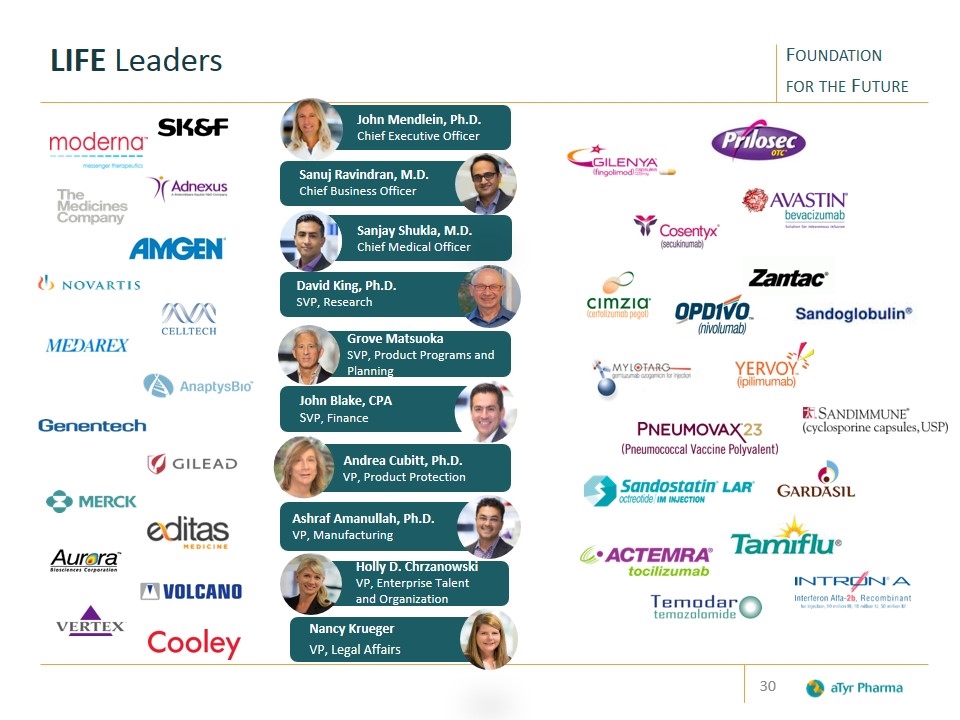
LIFE Leaders Foundation for the Future Andrea Cubitt, Ph.D. VP, Product Protection John Blake, CPA SVP, Finance Sanjay Shukla, M.D. Chief Medical Officer Holly D. Chrzanowski VP, Enterprise Talent and Organization Ashraf Amanullah, Ph.D. VP, Manufacturing John Mendlein, Ph.D. Chief Executive Officer Sanuj Ravindran, M.D. Chief Business Officer David King, Ph.D. SVP, Research Grove Matsuoka SVP, Product Programs and Planning Nancy Krueger VP, Legal Affairs
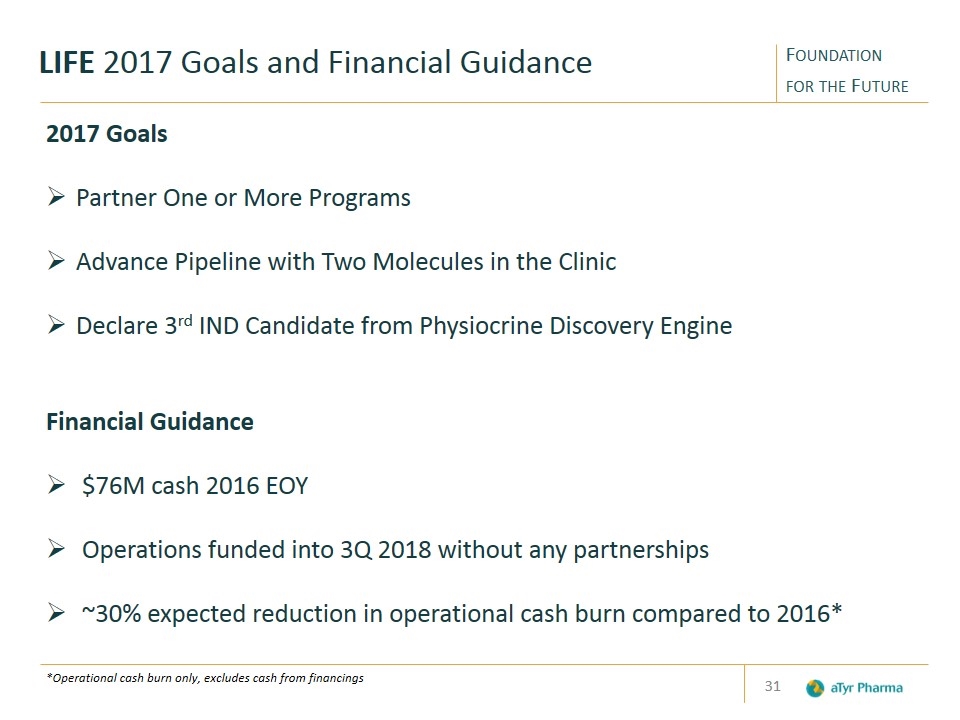
LIFE 2017 Goals and Financial Guidance *Operational cash burn only, excludes cash from financings 2017 Goals Partner One or More Programs Advance Pipeline with Two Molecules in the Clinic Declare 3rd IND Candidate from Physiocrine Discovery Engine Financial Guidance $76M cash 2016 EOY Operations funded into 3Q 2018 without any partnerships ~30% expected reduction in operational cash burn compared to 2016* Foundation for the Future

Thank you! Gracias Merci ありがとう Danke Khop Khun Mak Kha Obrigado Takk 감사합니다 Dziekuje Spasiba Grazie Mahalo Efharisto Sukria Nandri Cпасибо .תודה 谢谢 Shukran Terima kasih 多謝 متشکرم































